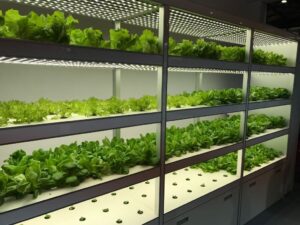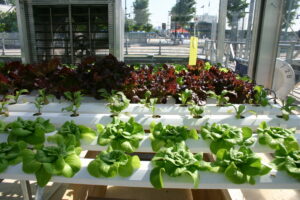Hydroponic Systems: A Comprehensive Guide for Indoor Cultivation
Hydroponic systems are becoming increasingly popular in the United States as people seek to grow their own fresh produce indoors, regardless of the season. Hydroponic systems are a type of soil-less gardening that uses nutrient-rich water solutions to grow plants, allowing for maximum growth in minimal space. In this article, we will explore the different types of hydroponic systems, how they work, the benefits of using them, and how to set up and maintain them.
Types of Hydroponic Systems
There are six main types of hydroponic systems: deep water culture, nutrient film technique, drip irrigation, ebb and flow, aeroponics, and wick systems.
Deep water culture, or DWC, is one of the simplest and most popular types of hydroponic systems. It involves suspending the plants’ roots in a nutrient-rich solution while a bubbler provides a constant flow of oxygen to the roots.
The nutrient film technique, or NFT, involves a continuous flow of nutrient solution over the plant’s roots, which are suspended in a shallow trough.
Drip irrigation systems use a timer to deliver nutrient-rich water to the plant’s roots through a series of drip lines.
Ebb and flow systems, also known as flood and drain, involve flooding the plants’ roots with nutrient-rich water before draining it back into a reservoir.
Aeroponic systems mist the roots with nutrient-rich water, while wick systems rely on a wick to draw water and nutrients up to the plant’s roots.
How do Hydroponic Systems Work?
Hydroponic systems work by providing plants with the nutrients they need to grow without soil. In these systems, water, oxygen, and nutrients are delivered directly to the plants’ roots. Without soil, plants can grow faster and healthier, with less water and space needed. Nutrient-rich water is circulated through the system, ensuring that the plants receive the nutrients they need to thrive. Additionally, this allows for precise control over the pH levels, nutrients, and water quality, resulting in more consistent growth and yields.
Benefits of Hydroponic Systems for Indoor Cultivation

Hydroponic systems offer several benefits for indoor cultivation. First and foremost, they allow for year-round cultivation, regardless of the weather outside. They also require less space and water than traditional gardening, making them ideal for small apartments or homes. Additionally, these are more efficient, as they allow for precise control over the plants’ nutrient intake, leading to faster and more consistent growth. Hydroponic systems are also more environmentally friendly than traditional gardening, as they require fewer pesticides and herbicides, leading to less pollution and soil erosion.
Setting Up a Hydroponic System Indoors: What You Need to Know
Setting up a hydroponic system indoors requires a few key components. First, you will need a growing tray to hold your plants. Next, you will need a reservoir to hold your nutrient-rich water solution. You will also need a pump to circulate the water and nutrients through the system, as well as tubing to connect the different components. Depending on the type of hydroponic system you choose, you may also need to grow lights to provide adequate light for your plants. It is important to research the specific requirements for the type of hydroponic system you plan to use to ensure optimal growth.
Hydroponic Systems vs. Traditional Gardening: Pros and Cons
While hydroponic systems offer many benefits, there are also some drawbacks to consider. This can be more expensive to set up initially, with costs varying depending on the type of system and the size of the operation. Additionally, hydroponic systems require regular monitoring and maintenance to ensure optimal growth and yield, which may be time-consuming for some individuals. On the other hand, traditional gardening can be less expensive and may require less maintenance, but it is also subject to weather conditions and pests.
Factors to Consider When Choosing a Hydroponic System

When choosing a hydroponic system, there are several factors to consider. The size of the system and the space available will dictate the type of system that will work best. The type of plants being grown will also play a role in the choice of system, as different plants have different nutrient and water requirements. The budget will also be a consideration, as some systems can be more expensive than others.
How Much You Can Expect to Spend For Hydroponic Systems?
The cost of a hydroponic system can vary greatly depending on the type and size of the system. A simple DIY deep water culture system can be set up for as little as $50, while a more complex aeroponic system can cost upwards of $1,000. It is important to budget for not only the initial setup costs but also ongoing costs such as electricity, water, and nutrient solutions.
Maintenance and Troubleshooting of Hydroponic Systems
Hydroponic systems require regular maintenance to ensure optimal plant growth and yield. This includes monitoring and adjusting pH levels, nutrient levels, and water levels. It is also important to keep the system clean to prevent the buildup of algae and other contaminants that can harm the plants. Troubleshooting common issues such as nutrient deficiencies, pests, and diseases is also important to ensure the health of the plants.
Conclusion: The Future of Hydroponic Systems in Agriculture and Gardening
Hydroponic systems offer a promising future for indoor cultivation and agriculture. As the world population continues to grow, the demand for fresh produce will only increase and offer a solution to growing food in limited space and water. Additionally, hydroponic systems offer a more sustainable and environmentally friendly alternative to traditional gardening.
